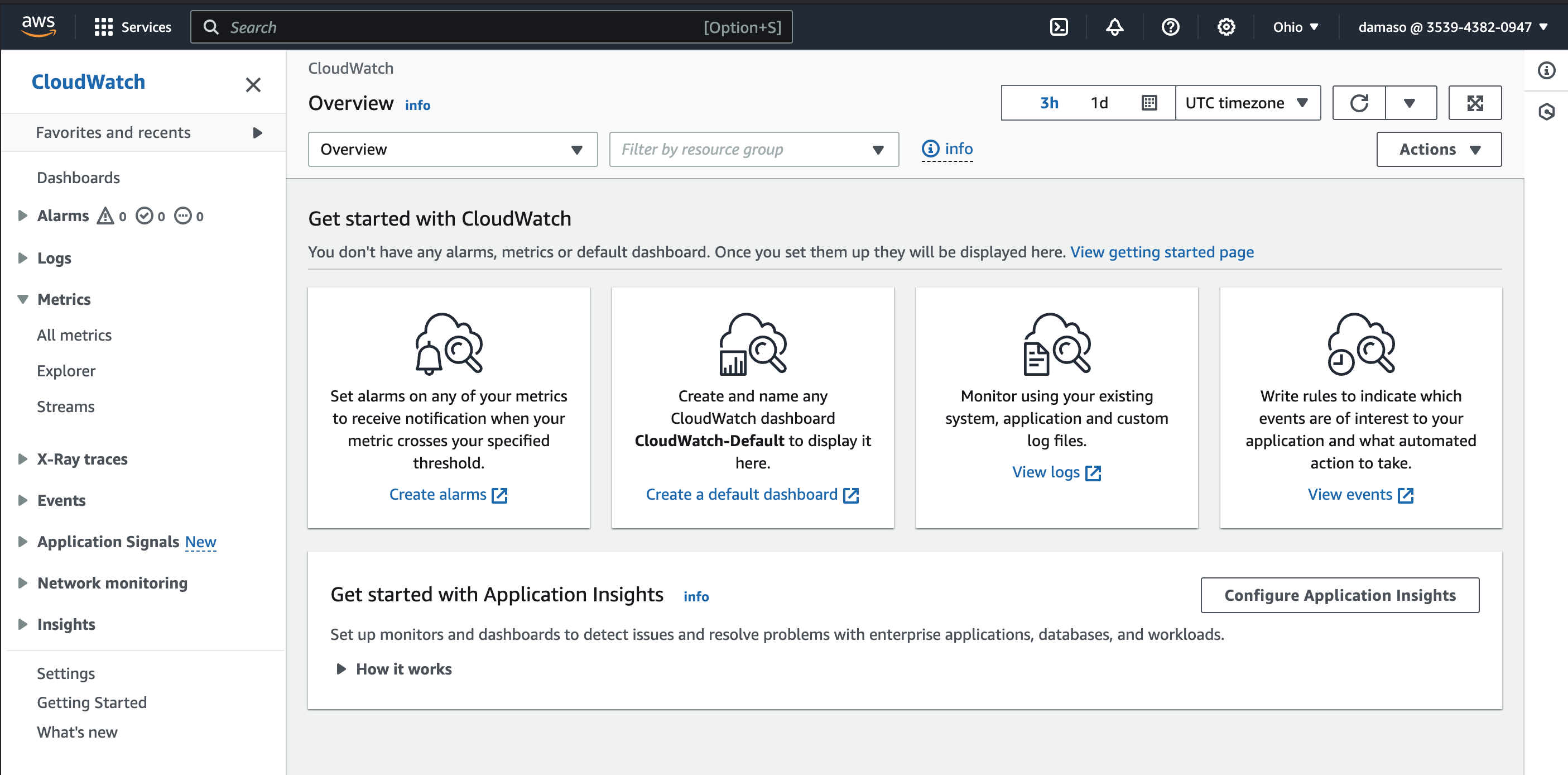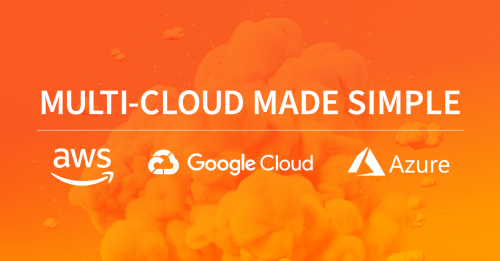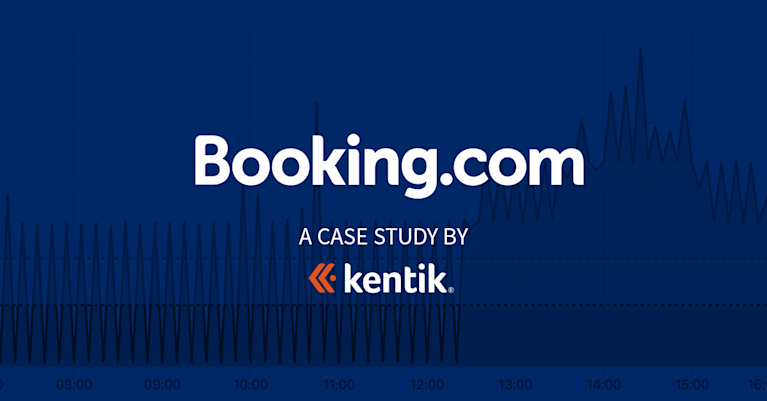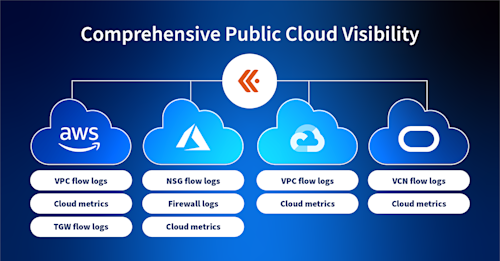Enterprise Cloud Monitoring: 5 Best Practices, Challenges, and Solutions
The multicloud approach offers unparalleled scalability, flexibility, reliability, and cost savings, allowing organizations to optimize performance, reduce downtime, enhance disaster recovery, and avoid vendor lock-in. However, as enterprises adopt multicloud strategies, maintaining a cohesive monitoring approach becomes increasingly challenging. This is because major cloud providers each offer their own first-party monitoring tools, such as Amazon Web Services (AWS) CloudWatch, Google Operations Suite, and Azure Monitor, which create fragmented visibility and inconsistent monitoring experiences.
This article guides you through the essential aspects of multicloud monitoring, introducing you to some best practices and addressing the limitations of relying solely on first-party tools. You’ll also be introduced to Kentik Cloud, a solution that provides a unified platform for monitoring multicloud networks, simplifying the oversight of diverse cloud environments.
Why Cloud Monitoring Matters
Neglecting monitoring leads to inefficient resource utilization, degraded application performance, and frustrated users. In contrast, effective cloud monitoring ensures smooth application operation, enhancing user satisfaction and system reliability.
Without monitoring, unidentified application problems can cause unexpected downtime. Effective monitoring detects issues early, allowing you to address them before they impact users, ensuring consistent uptime and reliability.
A lack of monitoring can also mean that vulnerabilities go unnoticed, exposing your system to potential threats. Effective monitoring identifies unusual activities, helping you mitigate security risks and protect sensitive data. Additionally, without oversight, cloud resources can be mismanaged, leading to unnecessary expenses. Effective cloud monitoring helps recognize and eliminate wasteful resource usage and ensures budget efficiency.
Cloud Monitoring Best Practices
Maintaining an effective monitoring strategy is critical for ensuring optimal performance and security. To achieve this, you need to adopt best practices tailored to the unique needs of your cloud environment.
1. Define Clear Monitoring Goals and KPIs
Setting specific goals and key performance indicators (KPIs) is essential for aligning your monitoring efforts with your desired outcomes. Clear goals make monitoring focused and effective, reducing wasted resources and missed opportunities. Additionally, these goals set the direction and purpose of your monitoring efforts, focusing on key objectives like enhancing system reliability, optimizing performance, reducing downtime, increasing security, and ensuring efficient resource use.
Once these goals are set, identify specific KPIs that accurately measure your progress. This approach ensures that your monitoring efforts are aligned with your organization’s broader objectives, making it easier to track success and make informed decisions.
For example, a streaming service might prioritize latency and reliability as key indicators of success, while an e-commerce platform may focus on transaction speed and security. Focus on metrics such as:
Application performance, which includes response times and error rates Resource utilization to ensure efficient use of cloud resources Adherence to service level agreements (SLAs) to meet contractual obligations Uptime targets to maintain high availability.
By defining and tracking KPIs, you can ensure your monitoring strategy delivers actionable insights that drive continuous improvement and operational excellence.
2. Monitor Across All Layers of the Cloud Stack
Effective cloud monitoring requires a holistic approach that encompasses the entire cloud stack. This means monitoring the health of your infrastructure, application performance, and network traffic simultaneously.
Each layer of the cloud environment is interconnected; a problem in one layer can cascade and affect others. For example, infrastructure issues such as resource contention can degrade application performance, while network bottlenecks can lead to latency and downtime.
Infrastructure monitoring should include CPU, memory, and storage metrics, while application performance monitoring should track response times, error rates, and user interactions. Network monitoring should focus on bandwidth usage, latency, and packet loss. Comprehensive oversight of all these layers ensures you can proactively manage and optimize your cloud environment, improving reliability, performance, and user satisfaction.
3. Leverage Automation for Efficiency
Automation in cloud monitoring is a game-changer that enhances operational efficiency. By automating data collection, you eliminate the need for manual data gathering, reducing the risk of human error and ensuring real-time accuracy.
Automated analysis tools can swiftly process lots of data and identify patterns and anomalies that might be overlooked by manual inspection. This allows for faster detection of potential issues, enabling faster response times.
Additionally, automated alerting systems can notify IT staff immediately when predefined thresholds are breached, ensuring timely intervention. When you implement automation, your team can focus on proactive problem-solving and optimization efforts rather than get bogged down with repetitive monitoring tasks. The proper use of alerts improves efficiency and enhances your cloud environment’s overall resilience and performance.
4. Establish Clear Escalation Procedures
Having well-defined escalation procedures is crucial for effective incident management in a cloud environment. These procedures ensure that issues are addressed promptly and by the right personnel, based on their severity.
Start by categorizing incidents into different levels of urgency, such as critical, major, and minor. For each category, outline specific steps for escalation, including who should be notified and what actions should be taken. Designate specific teams or individuals responsible for handling each type of alert.
Additionally, you should consider automating parts of the escalation process to trigger immediate notifications or even initiate automated remediation actions for certain types of issues. This approach minimizes response times, reduces the risk of prolonged outages, and ensures that the most qualified personnel addresses critical problems.
5. Continuously Review and Refine
If you want to keep pace with changing performance requirements and emerging security threats, you need to continually review and refine your monitoring strategy. This involves periodically assessing the effectiveness of your current monitoring tools and processes and identifying any gaps or areas for improvement.
You should make it a habit to update your KPIs and monitor parameters based on new business goals, technological advancements, and stakeholder feedback. Incorporate lessons learned from past incidents to enhance your monitoring setup. When you regularly review and refine your monitoring strategy, you ensure that your monitoring practices remain relevant and capable of addressing the dynamic nature of modern cloud environments.
Addressing the Challenges of Effective Multicloud Monitoring
After learning about the best practices that can help you implement effective cloud monitoring, it’s important to acknowledge the limitations of first-party cloud monitoring tools.
Limited Visibility Across Clouds
One significant limitation of using first-party monitoring tools is their inherent lack of visibility into other cloud environments. This vendor lock-in restricts organizations to a siloed view of their infrastructure and applications.
For example, AWS CloudWatch offers extensive metrics and insights for resources hosted on AWS but cannot provide visibility into Google Cloud or Azure resources. This limitation complicates efforts to maintain a holistic understanding of multicloud deployments, potentially leaving blind spots in monitoring that can impact performance and security. (Learn more about this topic in our blog post, “Understanding the Deficiencies of AWS CloudWatch for Cloud Visibility” or learn more about CloudWatch alternatives here.)
Multiple Interfaces and Learning Curves
Each cloud provider’s monitoring tool has its own interface and set of functionalities. Organizations using multiple clouds must navigate the learning curve of each platform’s monitoring tools, which can be time-consuming and require specialized knowledge.
For reference, here’s a screenshot of the AWS CloudWatch main dashboard:

Now, compare it to the Google Cloud Platform (GCP) observability dashboard:

While both serve the same purpose, each has its own unique nuances, gadgets, and learning curve.
Managing and learning multiple interfaces not only slows down operational efficiency but also increases the risk of human error in monitoring and managing cloud resources.
Data Consolidation and Unified Reporting Challenges
With monitoring data scattered across different cloud environments, consolidating this information into unified reports becomes a challenging task.
Organizations should strive for a cohesive view that encompasses all cloud platforms; this not only helps you make informed decisions but also ensures compliance. However, achieving this with first-party tools often involves manual processes or custom integration work, which can be resource-intensive and prone to errors. The inability to easily consolidate data undermines the effectiveness of multicloud monitoring, making it difficult to assess the overall health and performance of cloud deployments.
Provider Bias and Limitations
First-party monitoring tools can also be biased toward the provider’s services and best practices. While this is expected, it can limit an organization’s ability to implement a monitoring strategy that aligns with its specific multicloud objectives. The tools may prioritize metrics and alerts that are more relevant to the provider’s infrastructure, potentially overlooking critical insights pertinent to other cloud platforms.
For example, consider an application that uses Amazon Elastic Compute Cloud (Amazon EC2) and Simple Storage Service (Amazon S3) for computing and storage services and Azure SQL Database for its database needs. Monitoring and optimizing this setup poses a challenge because AWS CloudWatch effectively tracks and optimizes compute and storage metrics on AWS, but it doesn’t extend to monitoring Azure SQL Database performance. Similarly, Azure Monitor provides deep insights into Azure SQL Database performance but lacks visibility into AWS services. This disparity in monitoring tools complicates correlating data across clouds, making it challenging to identify and address inefficiencies or potential optimizations that span both environments.
Transitioning to cloud quickly complicates networking. Learn the top 3 AWS gotchas and how to avoid them.

Broader Challenges of Multicloud Monitoring
Beyond the limitations of first-party tools, managing separate monitoring solutions for each cloud platform introduces additional challenges, including increased costs, fragmented data, and the lack of a unified view.
Increased Costs
While AWS CloudWatch, Google Operations Suite, and Azure Monitor provide free-tier options, these tiers come with limited metrics and logs. As a result, most organizations need to subscribe to paid tiers, leading to higher operational costs.
Moreover, organizations may need training for IT staff and custom integrations, adding to the total cost of ownership. Organizations must balance these costs against the benefits of a multicloud strategy, often seeking more cost-effective and integrated monitoring solutions.
Fragmented Data
As explained, the use of disparate monitoring tools results in fragmented data, with each tool collecting and displaying information in different formats. This fragmentation complicates efforts to correlate data across cloud platforms, making it challenging to identify trends, perform root cause analysis, and optimize resources effectively.
Lack of Unified View
Achieving a unified view of the health, performance, and security posture of multicloud environments is perhaps the most significant challenge. A fragmented monitoring landscape makes it difficult to quickly assess the status of cloud deployments, respond to incidents, and ensure consistent performance and security standards across all cloud platforms.
Organizations must carefully consider these challenges when developing their cloud monitoring strategy, often looking toward third-party solutions that offer greater integration, unified reporting, and a holistic view of their multicloud environment. By addressing these challenges, companies can enhance their monitoring efficiency, reduce operational risks, and fully leverage the benefits of their multicloud strategy.
Unify Your Cloud Monitoring with Kentik Cloud
So far, we’ve identified that effective cloud monitoring involves setting clear objectives and KPIs, ensuring comprehensive monitoring across cloud layers, embracing automation, establishing easy-to-follow escalation frameworks, and engaging in ongoing refinement. However, despite the critical nature of these practices, first-party tools frequently fall short, particularly in multicloud setups, where they struggle to provide the depth and breadth of visibility required.
Thankfully, Kentik Cloud offers an efficient solution to these limitations. It serves as an essential abstraction layer and integrates data from a variety of cloud providers:

This integration ensures a single pane of glass for monitoring all cloud resources and guarantees a consistent monitoring experience across diverse platforms. By consolidating and analyzing information from multiple sources, Kentik Cloud provides holistic insights into the cloud environment. At the same time, its vendor-neutral approach also means organizations benefit from an unbiased solution that places equal emphasis on all cloud services. For example, here’s a detailed map of the AWS environment:

Kentik Cloud enables organizations to seamlessly meet their monitoring objectives, optimize their cloud infrastructure, and adhere to best practices, embodying a comprehensive solution for modern cloud challenges.
Learn How Kentik Improves Enterprise Cloud Monitoring
Kentik Cloud collects, analyzes, and contextualizes traffic flow and performance data from all major public clouds –- from Microsoft Azure, Google Cloud, AWS and Oracle Cloud Infrastructure –- along with data from on-premises networks. Kentik enriches all this network telemetry with deep application, business, and security context to provide observability across all hybrid and multicloud environments.
In this short video, Kentik’s Phil Gervasi demonstrates how Kentik ingests and visualizes data from various sources including public clouds, SaaS providers, private data centers, and more. See how you can drill down from a high-level overview to granular details such as specific IP addresses, VPC traffic, and cloud network performance metrics:
Kentik’s multicloud network observability solutions enable the collection, analysis, and visualization of flow logs generated on AWS Transit Gateways, as well as the automatic visualization of detailed Google Cloud, Microsoft Azure and hybrid cloud infrastructure topologies. These capabilities enable network, cloud, and infrastructure teams to quickly troubleshoot and understand multicloud traffic, future-proofing their organizations against the increasing network complexity associated with cloud adoption.
From your enterprise’s public cloud environments, Kentik collects telemetry including:

Kentik provides the tools and insights necessary for a seamless, secure, and optimized multicloud experience. Start a free trial or request a personalized demo today to learn how Kentik can help your enterprise on your multicloud journey.





